![]() Humans are natural splitters. We have an innate tendency to look at the world and mentally sort everything into different categories, and grades, and entities: this is one thing, that is another; it was this, now it’s that. Our perception of colour is a good example of how our brains automatically split a continuum into discrete boxes.
Humans are natural splitters. We have an innate tendency to look at the world and mentally sort everything into different categories, and grades, and entities: this is one thing, that is another; it was this, now it’s that. Our perception of colour is a good example of how our brains automatically split a continuum into discrete boxes.
We’ve incorporated our love of classification deep into science, trying to formalise and quantify the dividing lines we want to draw on everything: it’s this when conditions A and B are met, it’s that when we see Y and Z. But nature doesn’t often make it easy for us to draw our sharp dividing lines. We can exactly define state A and state B, but when something is gradually changing from one state to the other, when does it stop being A and start being B? We end up drawing our dividing line in the middle of the transition, even though there are signs of change before this line, and change continues on after it. In other words, the boundaries that we draw are almost always a little arbitrary, leading to uncertainty – and often disagreement – about where they should fall. The eternal debate over the best way to define a species is a prominent example of the problems that can arise when we try to draw sharp boundaries across fuzzy transitions that have depth, or width, or duration. In geology, the geological timescale is an entirely human contrivance, with the boundaries of periods and epochs delineating shifts in the state of the planet that might have taken hundreds of thousands or even millions of years.
A more topical boundary problem is provided by Voyager 1’s imminent entry into true interstellar space – the first manmade object to do so. I love that scientists are excitedly poring over data sent by a 35 year-old space probe, working far beyond its imagined operating lifetime. But it’s also clear from those data that the heliopause – the boundary between the sphere of the sun’s influence and the stuff outside – is one of those fuzzy boundaries writ large. One indicator being tracked by Voyager’s detectors, low energy cosmic ray particles that are generally unable to penetrate the heliopause, is spiking, possibly indicating the boundary is near. But two other important parameters – the level of lower energy particles produced by the sun (which can’t escape the other way across the heliopause), and magnetic field strength – are not yet changing as we’d expect. It seems that as we speak, Voyager 1 is now located somewhere between ‘definitely in the solar system’ and ‘definitely in interstellar space’.
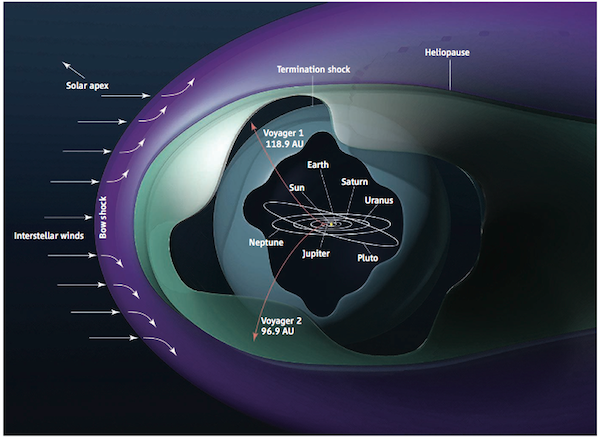
Voyager's location at the boundary between solar and interstellar space. Source: NASA/JPL
One of the issues is that because this is the first time we’ve crossed this particular boundary, we don’t know exactly what a transition looks like (we don’t know exactly what it looks like on the other side, either, which is why this is so exciting). It is often the case that until a boundary is crossed at least once, you can only tell when you actually crossed it in hindsight; then you can see the whole sequence of events and measurements that accompanied the transition, and define a boundary amidst them.
But what if you’re trying to define a boundary that you dont want to cross? Such is the case for the ‘Planetary Boundaries’ that attempt to attempt to define exactly how far we can push the planet’s ecosystems, atmosphere and hydrosphere without triggering irreversible changes.

The 'planetary boundary' concept attempts to quantify the resilience of the Earth's natural systems to human-driven change. Source: Rockstrom et al., 2009.
It seems that some people think the planetary boundary lines above have been drawn in the wrong place, or can’t be drawn at all. Nonetheless, given that our civilisation is rather finely tuned to the fairly narrow climatic range that we have enjoyed for the past 10,000 years or so, identifying any such critical thresholds is important – especially since we seem as hell bent on pushing beyond these boundaries as Voyager is on crossing the heliopause. Unfortunately, in the case of our complex, feedback-infested planet, not only are we unsure what exactly lies on the other side of any approaching boundaries, but monitoring our passage is also a much more difficult venture.
In theory, we geologists can provide a lot of help with identifying planetary thresholds: studying the progression of past, naturally driven climatic changes can give us valuable clues as to where the point of no return might be for the present, human driven one. An event of particular interest is the Paleocene-Eocene Thermal Maximum (PETM), an abrupt 5-6° C warming of the planet around 55 million years ago, which appears to have been caused by a massive fluctuation in the planetary carbon cycle. Last week we got treated to core drilled right through the PETM, pulled up from beneath the seafloor off of Newfoundland by the research drilling ship the Joides Resolution.
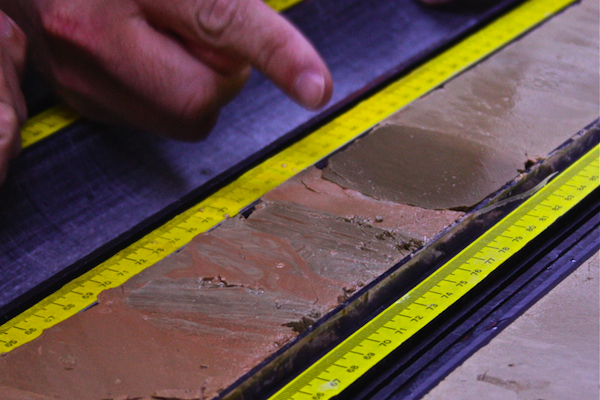
An oceanic sediment core containing the PETM boundary (the transition from red and grey to brown sediments, as pointed out by a helpful IOPD finger). Source: Joides Resolution Blog.
Here, at least, is a boundary that is easy to point at – an abrupt darkening in the colour of the sediment that marks where the warming killed off phytoplankton in the surface oceans, and shut off the steady rain of biologically produced carbonate onto the ocean floor. But ironically, in this case we might be faced with a boundary that is too sharp for its own good. The warming at the PETM took of the order of 10 to 20 thousand years, but Deep Time has taken this originally fuzzy boundary and squashed it into a few centimetres of core. Whilst this has made it easy to locate, it also means that information about how the transition actually occurred has been highly compressed, or even lost entirely. This is a recurring problem when you mix (relatively) rapid events with the geological record: in my own field of paleomagnetism, we have a similar problem when trying to find good records of magnetic field reversals.
So that’s the problem with drawing boundaries in science: more often than not, they’re either informative, and tricky to define; or easy to spot, and difficult to understand.

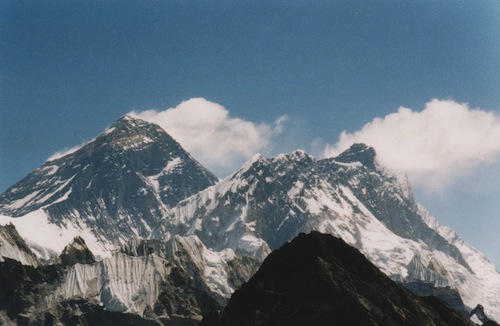

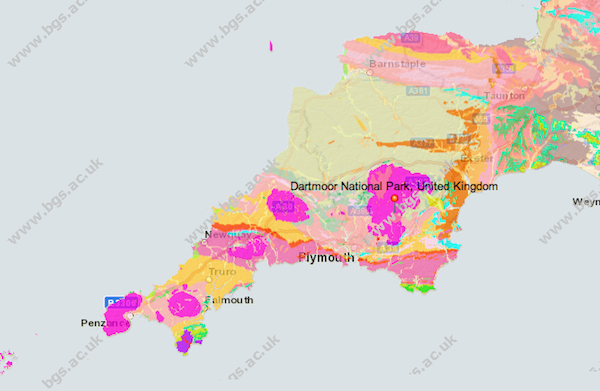
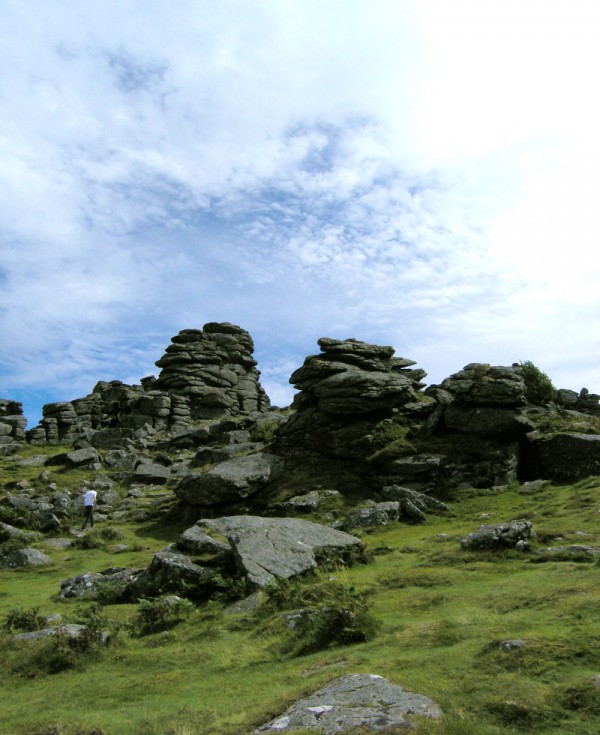

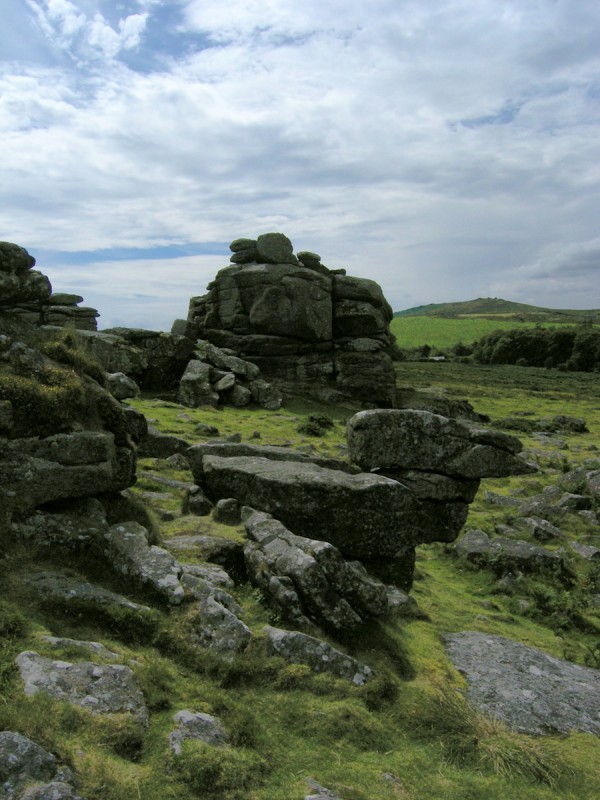







Nice plan for content warnings on Mastodon and the Fediverse. Now you need a Mastodon/Fediverse button on this blog.